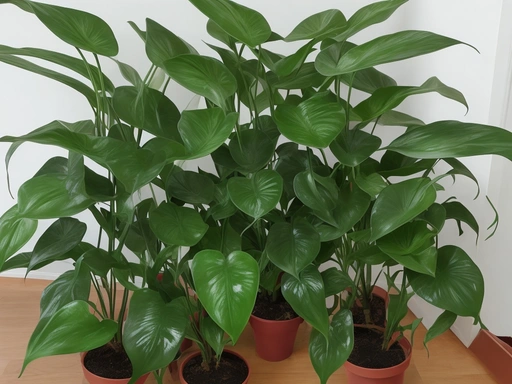Anthurium DIY Care Solutions for thriving plants!
Key Takeaways:
- Proper watering is crucial for healthy Anthurium plants.
- Provide adequate humidity and indirect light for Anthuriums to thrive.
- Regularly clean and dust Anthurium leaves to prevent pests and disease.
- Choose a well-draining potting mix and repot Anthuriums annually for optimal growth.
Welcome to our guide on Anthurium DIY care solutions! If you’re a plant lover like me, you probably adore the elegant beauty of Anthurium plants with their glossy leaves and striking flowers.
But let’s face it, just like any other plant, Anthuriums can face their fair share of issues.
Whether it’s brown leaves, wilting, or yellowing foliage, we’re here to help you identify and solve these common problems.
In this article, we’ll delve into the essential care tips, from watering techniques to lighting requirements, that will ensure your Anthurium thrives.
So, let’s dive in and become expert caretakers for our beloved Anthurium plants!
| Solution | Description |
|---|---|
| Proper watering | Water the plant only when the top inch of soil has dried out. Avoid overwatering or leaving the plant sitting in water. |
| Filtered light | Place the plant in a location with bright, indirect sunlight. Avoid direct sunlight as it can scorch the leaves. |
| Warm temperature | Maintain a temperature between 65-80°F (18-27°C) for healthy growth. Avoid exposing the plant to cold drafts. |
| Adequate humidity | Increase humidity around the plant by using a humidifier, placing it on a tray filled with water and pebbles, or misting the leaves regularly. |
| Well-draining soil | Use a well-draining potting mix that retains some moisture but allows excess water to drain quickly to prevent root rot. |
| Regular fertilization | Feed the plant with a balanced liquid fertilizer diluted to half strength every 4-6 weeks during the growing season. |
| Pruning | Remove dead or yellowing leaves and trim back leggy growth to maintain a tidy appearance. |
| Pest control | Monitor the plant for pests like mealybugs or spider mites. Use appropriate organic or chemical methods to control the infestation. |
Common problems faced by Anthurium plants
Anthrium plants commonly face issues such as brown leaves, wilting, and yellowing leaves.
Identification and solutions for common issues such as brown leaves, wilting, and yellowing leaves
Brown leaves, wilting, and yellowing leaves are common issues in Anthurium plants. Brown leaves can indicate underwatering or direct sunlight.
To fix this, adjust watering and move the plant to a shaded area.
Wilting is often due to overwatering or poor drainage. Check the soil moisture and improve drainage by repotting.
Yellowing leaves can be caused by excessive sunlight, nutrient deficiencies, or root problems.
Adjust lighting conditions, fertilize regularly, and check for root rot.
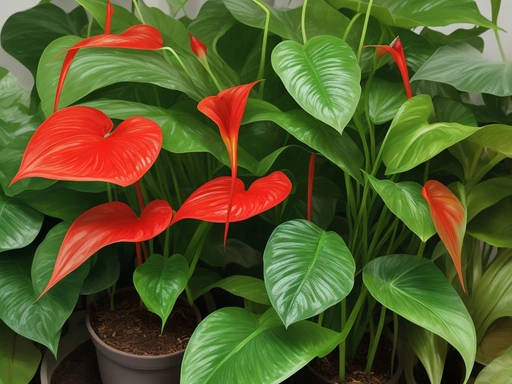
Watering Anthurium plants
Watering Anthurium plants – how to do it right.
Proper watering techniques and frequency for Anthurium plants
To properly water Anthurium plants, ensure the top inch of soil is dry before watering again.
Water thoroughly until it runs out of the drainage holes, then discard any excess water.
Avoid overwatering as it can lead to root rot.
Watering once or twice a week is usually sufficient depending on the temperature and humidity levels.
Adjust the frequency accordingly.
Remember to use room temperature water and avoid wetting the leaves to prevent leaf damage.
Light requirements for Anthurium plants
Anthurium plants thrive in bright, indirect light, making them ideal for indoor spaces with filtered sunlight.
Best lighting conditions for Anthurium plants and how to provide adequate light
Anthurium plants thrive in bright, indirect light. They enjoy being near a window with filtered sunlight or under fluorescent lights.
Avoid placing them in direct sunlight as it can scorch their leaves.
To provide adequate light, ensure they receive 6-8 hours of bright, but not direct, light per day. Use sheer curtains or place them a few feet away from a bright window.
Temperature and humidity needs for Anthurium plants
Understanding the ideal temperature and humidity levels for Anthurium plants and how to maintain them.
Understanding the ideal temperature and humidity levels for Anthurium plants and how to maintain them
The ideal temperature for Anthurium plants is between 65-85°F (18-29°C). They prefer a humidity level of 60-80% to thrive.
To maintain these conditions, place the plants in a well-ventilated room away from drafts and temperature fluctuations.
Mist the leaves regularly and use a humidifier if necessary. Monitor the temperature and humidity levels with a thermometer and hygrometer.
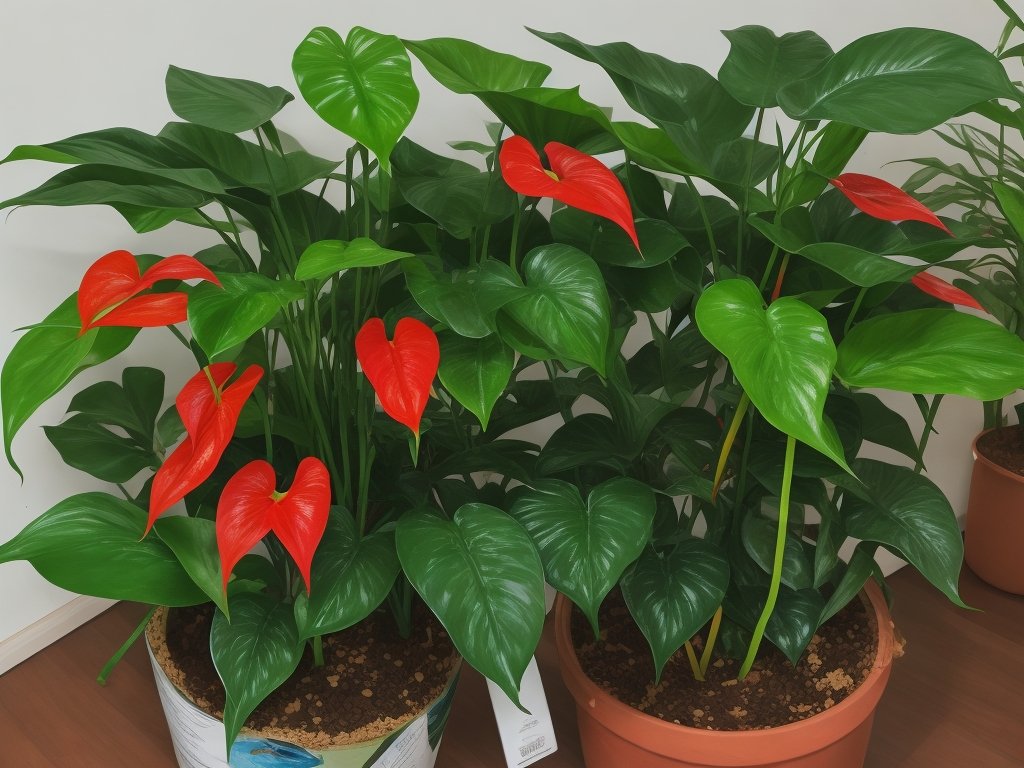
Potting and soil requirements for Anthurium plants
Choosing the right pot and soil mix for Anthurium plants and repotting when necessary are important for their care.
Choosing the right pot and soil mix for Anthurium plants and how to repot them when necessary
To choose the right pot for your Anthurium, look for one that is slightly larger than the current pot, with drainage holes.
For the soil mix, use a blend of peat moss, perlite, and orchid bark for good drainage.
When repotting, gently remove the plant from its current pot and loosen the roots.
Place the Anthurium in the new pot and fill around it with the soil mix.
Water thoroughly and place in a spot with bright, indirect light.
Feeding and fertilizing Anthurium plants
To feed and fertilize Anthurium plants, you need to consider the right type of fertilizer and follow some helpful tips.
Tips on fertilizing Anthurium plants and selecting the right type of fertilizer
To properly fertilize your Anthurium plants and choose the right fertilizer, here are some tips:
- Use a balanced fertilizer with equal parts nitrogen, phosphorus, and potassium (10-10-10 or 20-20-20.
- Apply the fertilizer every two to four weeks during the growing season (spring and summer.
- Dilute the fertilizer to half the recommended strength to avoid burning the roots.
- Water your plant thoroughly before fertilizing to prevent root damage.
- Avoid over-fertilizing, as this can lead to salt buildup and damage the plant.
- Consider using a slow-release fertilizer for a consistent nutrient supply over time.
- Keep an eye on your plant’s response to the fertilizer – if it starts showing signs of burn or nutrient deficiencies, adjust the fertilization frequency or strength accordingly.
Pruning and grooming Anthurium plants
Pruning and grooming Anthurium plants is essential for promoting healthy growth.
How to properly prune and groom Anthurium plants to encourage healthy growth
Proper pruning and grooming of Anthurium plants is essential for their healthy growth.
Here’s how you can do it:
- Remove dead or yellowing leaves: Trim any dead or yellowing leaves by cutting them off at the base. This will prevent the plant from wasting energy on maintaining these unhealthy leaves.
- Trim long or leggy stems: If your Anthurium plant has long, leggy stems, you can give it a more compact and bushy appearance by trimming the stems back. Cut just above a leaf node to encourage new growth.
- Prune for shape: Anthurium plants can sometimes grow in uneven or unattractive shapes. Prune back any unruly stems to achieve a more balanced and aesthetically pleasing form.
- Remove spent flowers: After your Anthurium plant has finished blooming, you can remove the spent flowers. This will encourage the plant to allocate energy towards new growth and the production of new flowers.
- Clean and groom: Dust can accumulate on the leaves of Anthurium plants, which can hinder their ability to photosynthesize. Wipe the leaves gently with a damp cloth to remove dust and keep them looking healthy.
Proper pruning and grooming will not only enhance the appearance of your Anthurium plant, but it will also promote healthy growth and encourage the production of more blooms.
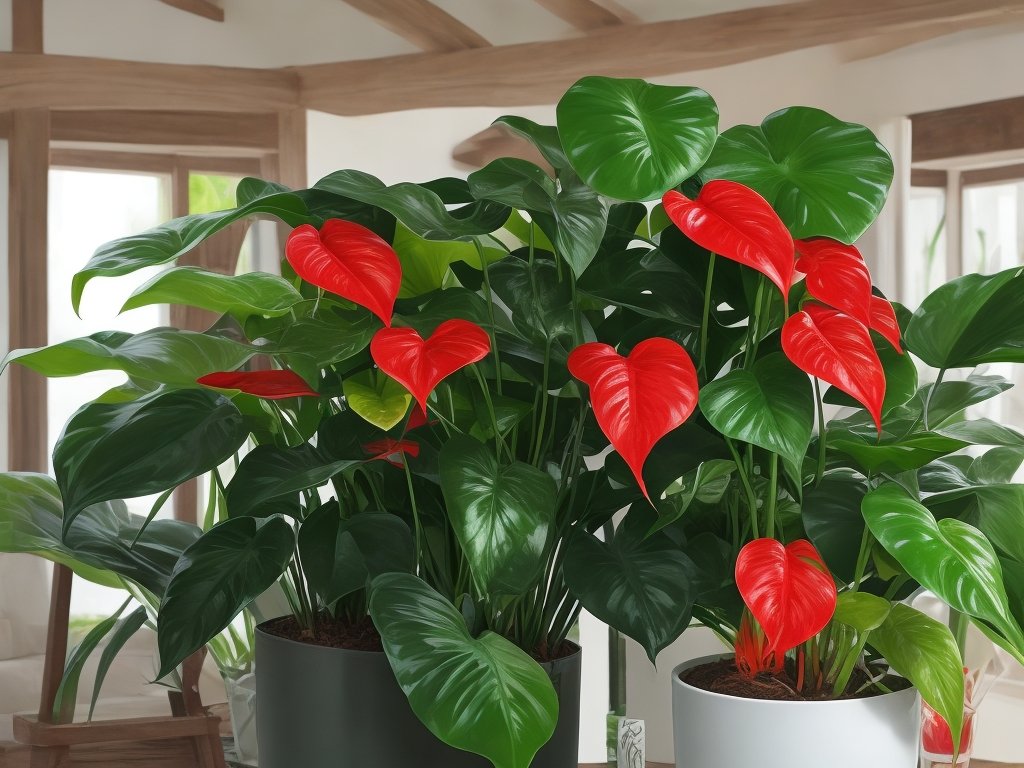
Propagation methods for Anthurium plants
You can propagate Anthurium plants through division, offsets, and stem cuttings.
Step-by-step instructions on propagating Anthurium plants through division, offsets, and stem cuttings
To propagate Anthurium plants through division, follow these steps:
- Choose a healthy and mature Anthurium plant with multiple stems or offsets.
- Gently remove the plant from its pot and inspect the roots to identify natural divisions or offsets.
- Use clean and sharp gardening shears or a knife to carefully separate the divisions or offsets from the main plant.
- Ensure that each division or offset has a few roots attached.
- Plant each division or offset in a separate pot filled with well-draining potting soil.
- Place the pots in a warm and humid location, away from direct sunlight.
- Keep the soil lightly moist, but avoid overwatering to prevent root rot.
- Monitor the newly propagated plants regularly and provide them with the same care as mature Anthurium plants.
For propagating Anthurium plants through stem cuttings, follow these steps:
- Select a healthy stem from the parent plant that has at least two leaves.
- Using sharp and sterile pruning shears, cut the stem just below a node, which is where the leaf is attached.
- Remove the lower leaves, leaving only two to three leaves at the top.
- Dip the cut end of the stem in rooting hormone to promote root formation.
- Plant the stem cutting in a pot filled with moistened potting soil or a mix of perlite and peat moss.
- Place the pot in a warm and bright location, but away from direct sunlight.
- Keep the soil consistently moist and mist the leaves regularly to maintain humidity.
- After a few weeks, roots will form, and the cutting can be treated as a mature Anthurium plant.
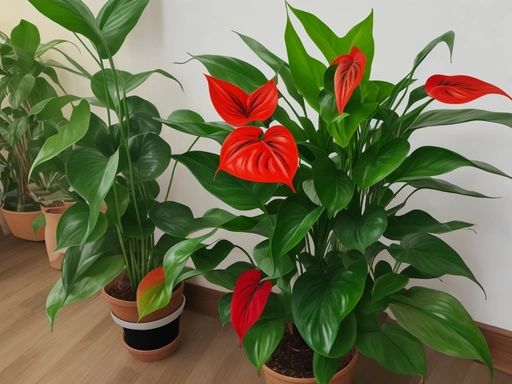
Common pests and diseases affecting Anthurium plants
Anthurium plants can be affected by common pests like aphids, fungus gnats, and diseases such as root rot.
I’ll tell you how to identify and treat these issues.
Identifying and treating common pests and diseases, such as aphids, fungus gnats, and root rot
Identifying and treating common pests and diseases in Anthurium plants is essential for their health.
Aphids can be identified by their small size, often green or black color, and the sticky residue they leave behind.
Use insecticidal soap or neem oil to treat aphid infestations.
Fungus gnats are tiny flying insects that thrive in moist soil.
Allow the soil to dry out between waterings and use sticky traps to catch adult gnats.
Root rot is caused by overwatering and poor drainage.
Remove affected parts and improve drainage to prevent further damage.
Frequently Asked Questions
Addressing common questions about Anthurium care, including how often to water, when to repot, and what to do about yellow leaves.
Anthurium plants should be watered when the top inch of soil is dry.
Repotting should be done every 1-2 years, or when the roots start to outgrow the current pot.
Yellow leaves can be caused by overwatering, underwatering, or nutrient deficiencies.
Adjust watering and provide appropriate fertilizer to address yellow leaves.
Final Verdict
Caring for Anthurium plants doesn’t have to be a daunting task.
ensure your Anthurium plants thrivebrown leaves, wilting, and yellowing leaves, and providing solutions such as proper watering techniques and best lighting conditions, you can ensure your Anthurium plants thrive.
Understanding ideal temperature and humidity levels, choosing the right pot and soil mix, and knowing how to feed and fertilize are also crucial.
Additionally, learning how to prune and groom, propagate, and tackle pests and diseases will contribute to the overall health and beauty of your Anthurium plants.
With these DIY care solutions, you’ll have luscious and vibrant Anthuriums enhancing your indoor or outdoor space in no time.



